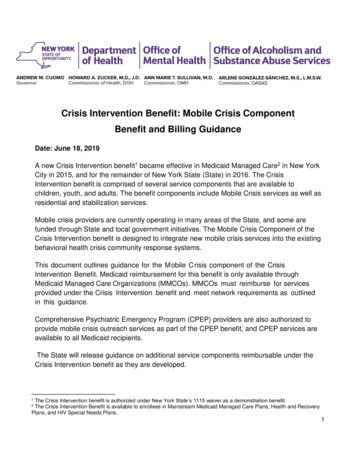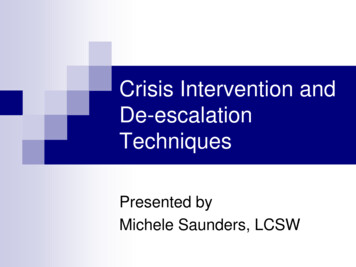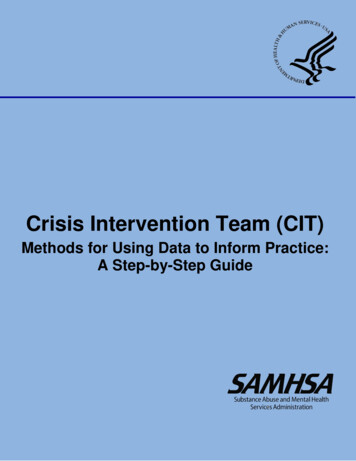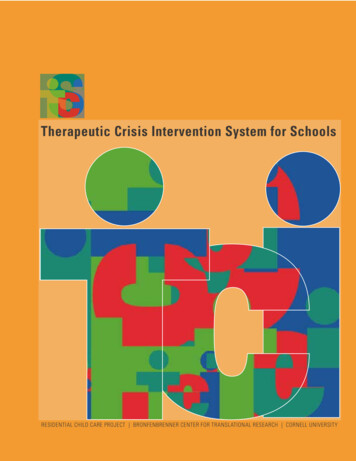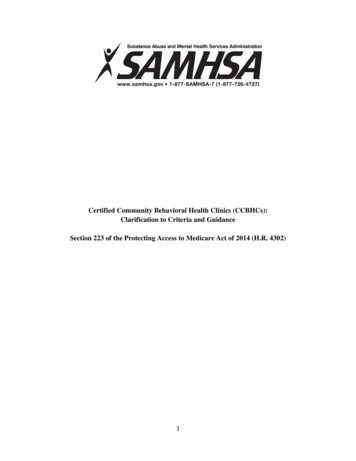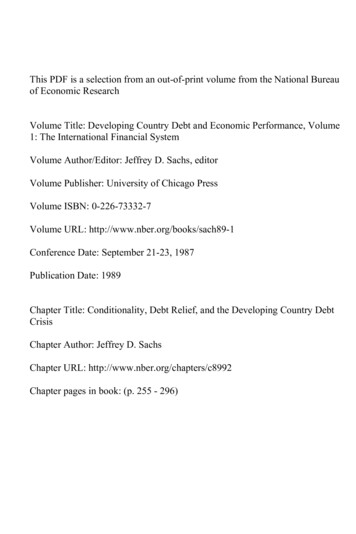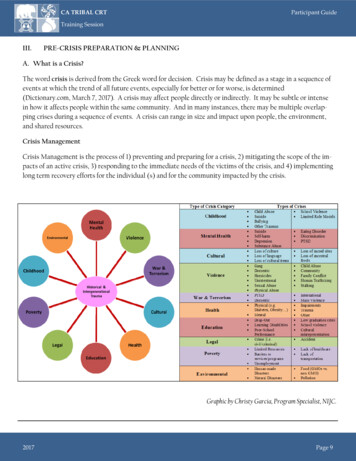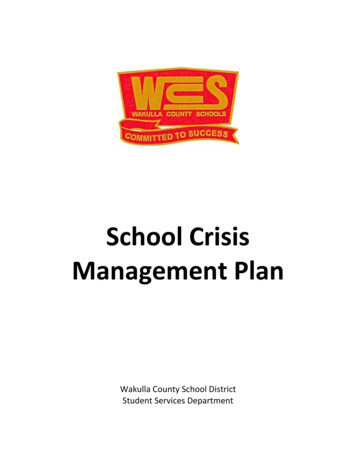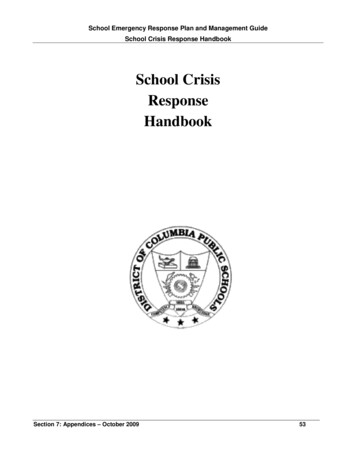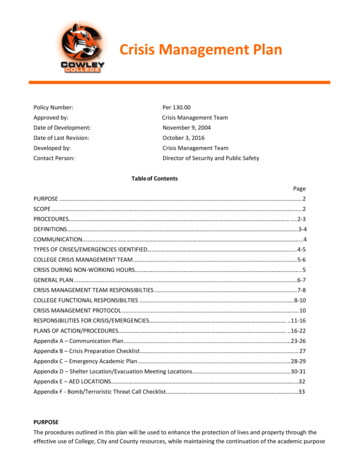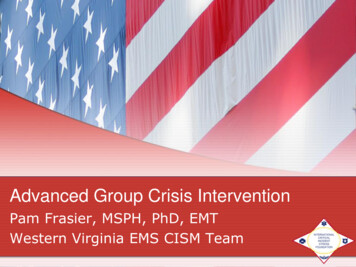
Transcription
Advanced Group Crisis InterventionPam Frasier, MSPH, PhD, EMTWestern Virginia EMS CISM Team
For Your ReferenceCourse Name:Advanced Group CrisisIntervention: Strategies and Tacticsfor Complex SituationsCourse Dates:November 6-7, 2013Course Number: 21311064329466Course Location: Norfolk, VAInfo for Ordering a Replacement Certificatefrom ICISF (410) 750-9600
Course OutlineSection 1 Section 2 Section 3 Section 4 Section 4BSection 4CSection 6A/BSection 6C –Section 5A/B*Section 7 *Section 8 -Introduction-CISM Review of Core ConceptsPrinciples of Group ProcessEnhanced Group ProcessesComplicated Group InterventionsSignificantly Delayed Group InterventionMultiple Incident CISD- Line of Duty Death CISDPost Action Staff Support- Suicide of a Colleague/Co-worker CISDCISM in DisastersOther Challenging Group Interventions:The Symbolic CISD, CISD Children
Core Concepts of CISM and GroupInterventionsSection 1
CISM CHALLENGE !! THREE TEAMS OF FIVE
Principles of Group ProcessSection 2
A Group A collection of any number of people(2 ) between whom such relationsare discovered that they must be thought of together A number of people whose relations toeach other are sufficiently impressiveas to demand attention.
Three Types of GroupsPrimary Families Teams EMS Military Units Clubs Social/ChurchGroupsHomogenous“Be One of Us”RandomSecondary Platoon Schools LargeBusiness ProfessionalAssociations Disaster VictimsTravelersMall ShoppersTheatreAudiences Hostages on atrainHeterogeneous
The majority of the Advanced GroupCrisis Intervention course relates toprimary groups.
All Primary Groups Must DealWith These Group Dynamics Expectations Leadership Attraction Norms Communication Cohesiveness
Group Leadership Styles Laissez-faire – Whatever goes Authoritarian – Strict control Democratic – Participation in leadership bygroup members
Items Valued By Group Members in Crisis Early intervention Validation/Catharsis Group support Education, coping, cognitive reevaluation Opportunity for follow-up
Factors Valued by Groups in Crisis Impartinginformation Instilling hope Altruistic Universal concepts Correctiverecapitulation Using socializingtechniques Initiatinge behaviors Interpersonallearning Building groupcohesiveness CatharsisYalom’s Ten Factors for Effective Groups
Common Problems in Group ProcessSection 2-A
Common Problems in Group CrisisIntervention Not understanding the Mechanisms ofAction Early intervention Validation/catharsis Group support Education, coping, cognitive re-evaluation Opportunity for follow-up
Common Problems inGroup Crisis Intervention Lack of Understanding of Mechanisms or“active ingredients” Failure to incorporate mechanisms of actioninto the intervention program Inappropriate Timing (“Timing” refers topsychological readiness more than a passage oftime) Too large a group A group that is too heterogeneous
Common Problems inGroup Crisis Intervention Faulty Introduction and Guidance Inability to set appropriate expectations Lack of leadership Failure to motivate participants Failure to reassure group members Failure to encourage group members Failure to guide group process Allowing operational critique Evaluation of performance Focus on anger and blame Failure to achieve closure in a group
Common Problems inGroup Crisis Intervention Failure to follow the structures Each group process has two structures Knowing the procedural steps or stages ofthe protocol Knowing when to use 7-stage vs. 5-stage Understanding the psychological domains Cognitive domain (Left-brain) Affective domain (Right-brain) Failure to follow-up
Common Problems inGroup Crisis Intervention Cognitive versus Affective Domain– Participants rush from facts (cognitive) toemotions (affective)– Emotional tirade or dysfunctional catharsis– Tendency to avoid affective stage– Intrusion of past events– Attempting psychotherapy instead of crisisinterventionParaphrase is the best technique to transitionbetween phases
Common Problems inGroup Crisis Intervention Teaching– Not practical Re-entry– Failure to return to cognitive– Failure to actively work for closure of theprocess– Inability to achieve group closureSummarization is the best technique to fosterclosure of the group process
Enhanced Group ProcessesSection 3
Purposes of Small Group CrisisIntervention Prevent unnecessary after-effects Accelerate normal recovery Stimulate group cohesion Normalize reactions Stimulate emotional ventilation Promote cognitive grip on the situation
Factors Inhibiting Group Communication Personal integrity issues Personal identity issues Power Influence Control Acceptance
Communications Can Enhance orInhibit All Groups in the Areas of: Goals Personal identification Power Intimacy
General Principles ofEnhanced Group Process Efficient groups allow access to leadership Some individuals may influence leadership andthus produce internal conflict Centralized leadership helps organization, &efficiency, but at the cost of some morale. The more open the communication, thehigher group morale, but efficiency may belessened
The more complicated the group process,the greater the need for structure.Example:Defusing 3 phasesCritical Incident Stress Debriefing 7 phasesStructure in Crisis Groups EnhancesEfficacy-Rhode and Stockton, 1994
Communication Phases in Groups Introduction Transition Process Closure
Effective Communicators Attend to group and group members Empathize appropriately Summarize vital points Ask appropriate questions Show genuineness/respect Use assertiveness/careful confrontation Problem solve
Effective Communicators Respond actively Take initiative Communicate concretely Use accurate empathy Challenge gently Enhance feedback
Communication Skills: Challenge GentlySometimes you have to gentlychallenge people in crisis groups andthat is an art Identify strengthsAdvanced accurate empathyMild confrontationImmediacy (Do not wait to gently challenge ina group)
Communication skills combined with aoutgoing assertive leadership style arethe most essential elements of effectivegroup crisis intervention
Group Crisis Interventions: PracticalTasks What activity is going on in the group?Leader focuses on speaker in groupCo-leaders focus on rest of groupListen for common themes in a groupBe directive in crisis groupsModel behavior for the group membersIdentify issues that need individualattention after the meeting
Team Leaders Active at timesPassive at othersAlways demonstrating overall leadershipAllowing silence to workAvoiding unnecessary probingStopping destructive processes - TakingCharge Further explore something. “I want toclarify something before we move on”
Leader Tasks in Crisis Groups Quickly establish atmosphere of trust Outline goals and motivate for participation Build relationship to the group and itsindividual members Be a role-model for the group Choose, address and time important issues Guard against destructive group processes Stimulate and fine–tune a positive groupprocess(Dyregrov, 2003)
Three Key Issues in Group Work Trust Authority Structure
Communication Skills: Eye Contact Essential Balanced side to side and around theroom Do not make people self conscious oroverlooked Do not avoid eye contact by lookingaround the room or at objects Do not overdo the eye contact
Communication Skills: Body Posture Carries a message Signals attention or lack of it Signals respect for the group Lean toward group members. It implies, “I am engaged and attentive”
The more rigid the leader appears to bein a group the less approachable he orshe appears to be to the groupmembers.
Engage Individuals in SupportiveConversation Beginning, middle, end “Sir, what was your part?” “I see” or “That must have been difficult.” “Thank you” or “We appreciate that.” Never lose sight of the whole group
Use the Group When You Can Acceptable: “That reaction is verycommon.” Much better: “Did other members ofthe group experience the same thing?”
Leader Reaction to an Individual In Group WithPrior Traumatic Life Event“This is something that is quiteimportant to you and I would like to takesome time after the meeting to discuss itfurther with you.”
CISDvs. Group PsychotherapyCISD CISD focuses onwhole group withoutforgetting theindividualPsychotherapy Group psychotherapyhas a much greaterfocus on eachindividual in a group.
Rule of 3 GuidelineThree follow-up questions to the same person on same subject matter usually characterizes psychotherapy
Psycho-Educational versus ProcessNo limit on size (?)15 people maxEmphasis on informationGroup SupportSomewhat more passiveMore activeLeaders normalizeGroup normalizesLeaders are a resourceLeaders informGroup is a resourceLeaders modelUSA / Canada / AustraliaEuropeCISD is a complex groupprocessCISD is a complex groupprocess
Mental Health background is noguarantee for making good crisis teammembers.Training in structure and process of thecrisis group determines ability to lead agroup.
Greater experience in groupleaders is associated with favorableparticipant perceptionsLevin and Kurtz, 1974
Review: CISM and Group Crisis Intervention:“Friendly Fracas” Group Competition Three participants volunteer to act as “judges” todetermine which group responds first when theanswer is shown on the screen. Two- four teams of players formed. All players must be able to see the projectionscreen. All participants agree to accept the ruling of themajority of the judges on who raised his/herhand first. The moderator will read the first question and thefirst person from either team who responds willbe allowed to answer the question.
Pre CISD Preparation is Vital Training Knowledge Experience Familiarity with group Details of event Strategic plan
Seven Factors Influencing Process andOutcome of Group Crisis ess andOutcomeParticipantsStructure andFlow of MeetingGroupOrganization(Atle Dyregrov)
Group Environment Time since event Physical surroundings distractions; Disturbances (cell phones, pagers, etc.) Seating positions, CISM leaders’placement Duration of meeting (“We will sit with youuntil it is finished.”) Table or not, chairs Size of room, lighting, Refreshmentsduring/ after
Exposure Sensory impressions Life threat Losses Homogeneity of group Heterogeneity of group
Leadership TrainingExperiencePreparationLeader co-leaderinteractions /interventionapproach Listening ability Communication skills Educational ability Level of activity inthe group Respect for thegroup Gender Knowledge of thejob Understanding of thegroup Unspecified factors(Dyregrov, 2003)
Participants Personalities Training Experience Age Prior traumatic events Support systems
Organization Acceptance Role distribution Crisis routines Previous gexperience, etc.
Group Nature of groupWork groupStranger groupHistoryCultureGenderCohesionConflictSize
Culture of the Group Supervisor in group may heighten fear Mandated or voluntary? Does resistance reflect leadershipattitude? CISD acceptable or not? Openness a sign of weakness?
Structure and Flow of Meeting RulesUtilization of rulesGoalsOperating proceduresIntervention focusDisruptive influencesFacilitative influencesObstacles(Dyregrov, 2003)
Leader Tasks in Crisis Groups Quickly establish atmosphere of trust Outline goals and motivate for participation Build relationship to the group and itsindividual members Be a role-model for the group Choose, address and time important issues Guard against destructive group processes Stimulate and fine–tune a positive groupprocess(Dyregrov, 2003)
CISM Team Leader CompetitionHampers Group Crisis Intervention Process Cooperation is enhanced by the wayleaders address one another Non-verbal cues Respect
Negative Outcome for MembersCan Result From Domination of group by one member Open conflictBlaming, scapegoating Exposure to traumatic details, secondarytraumatization Triggering of unwanted reactions or material Leader / co-leader competition for leadership
Negative Outcomes for Group Members Promotion of incorrect informationregarding - facts, normal reactions, copingtactics to use Inappropriate use of shared informationoutside of the meeting Mishandled group processes such asresidual feelings (anger, guilt, bitterness,sadness) or destabilization ofpsychologically unstable persons
Group Dissenters Take too much time Try to sabotage group Resist leaders Resist process Focus on their own needs Attack others
Managing Dissenters Friendly but firm leadership Escalate strength of correction if badbehavior persists Do not harshly correct (group will turn onleaders) Do not under react (group loses faith in theleadership) Make sure a rule is stated in introductionthat there will be a democratic use of thegroup’s time
Group Exercise: ProblemParticipant(s) How would you handle theseparticipants?
CISD Strategy to Achieve ResultsActivityAimIntroduction-Introduce Establish climate,leaders/Purpose and rules decrease anxiety, buildtrust, signal structureof CISDFact–Relate facts andbriefly review eventCreate wholeness andcommon understandingof the real exposureThought-Relate thoughts Stimulate coherentand decisionsunderstanding
CISD Strategy to Achieve ResultsActivityAimReaction – review ofworse aspects & reactions.Put images in wordsConfrontation of theexposureActivate team resourcesthrough the group processSharing responsibilityNormalizationSharing of coping methodsPrevent intrusive imagesReduce tensionPrevent avoidant behaviorMobilize team unity andsupportPrevent rumination andblameEnhance coping resources
CISD Strategy to Achieve ResultsActivityAimSymptoms – relateemotional and somaticreactions to eventDecrease emotionalinvolvement and personalidentificationGain perspective.Secure rapid normalization
CISD Strategy to Achieve ResultsActivityTeaching – provideverbal and writteninformationSuggest coping methodsRelaxation, self talk,handling intrusionsEncourage writing aboutevent plan for futureEncourage group andfamily supportAimMore rapid normalizationprovide a frame ofreferenceDecrease arousal andfear; activate stressmanagement processesOffer a sense of controlRemove sense ofhelplessness
ActivityRe-entry – Focus onlessons learnedSummarize, wrap upIdentify resourcesAimSecure future copingSense of completenessGive access to futurehelp
The Introduction is Essential Provides structureDefines boundariesBuilds trustDecreases anxietyFoster acceptanceEstablish temporary cohesivenessMotivates participantsPrepares for the phases to come
The Introduction Is Essential Rules raise expectations Regulate process Secure control Facilitate trust Overcome resistance Orient group Shift responsibility to leaders(Dyregrov, 2003)
Introduction Preparatory lecture strengthens aclient’s faith in the process Gets people oriented to the here andnow interaction among participants The 5-8 minutes of an introduction canbenefit the entire process Guidelines tell group that CISD hasstructure and clear leadership
Follow-up Meeting Short introduction – less formal thanCISD Any new facts? What kind of thinking have you beendoing since the CISD Changes in reactions over time? Discuss various coping tactics What has improved for you? What else might help?
General Notes onCrisis Intervention Groups Group conflict makes CISD more difficult Surprise in groups is most disruptive Nature of group will make a huge difference(male vs. female, homogeneous,heterogeneous) Males tend to stick to facts. Females movemore quickly toward emotions. Make surefact and thought phases adequately coveredto maintain structure.(Dyregrov, 2003)
General Notes onCrisis Intervention Group Processes Random groups (disaster victims)require less emphasis on groupcohesion Target, Type, Timing, Theme andTeam Natural cohesion of group can enhanceCISD Cohesion depends on history,experience, prior CISD, level oftraining in field of CISM
General Notes onCrisis Intervention Groups Males need more time on the facts andthoughts before moving towardemotionally laden material. They strugglemore to put emotions into words. Collaboration, team effort, success andmutual group support are more importantin CISD with emergency personnel.
Be Alert !! Some group exclusion may occur afterCISD Follow-up may be required to ”head off”group exclusion On occasion, one or two members of agroup or unit who were not involved in theevent may need to be part of the CISD orFollow-up to avoid post-CISD exclusion
Benefits of Group Intervention “peer support groups constitute apowerful social support intervention Bymeeting with those who are contendingwith similar problems, members canprovide emotional support to eachother as well as share information andeffective coping strategies.”(Hinrichsen, G. A., Revenson, T.A. & Shinn, M. (1985).Does Self-Help Help? An Empirical Investigation of Scoliosis PeerSupport Groups. Journal of Social Issues, 41(1), 65-87.)
Review: CISM and Group Crisis Intervention:“Friendly Fracas” Group Competition The moderator will read the first question and thefirst person from either team who responds willbe allowed to answer the question. If the answer is one of the three answersprovided by the survey, the person operatingthe computer will display the answer and pointvalue. (Please note this is different from the populargame show in which each team is able to answer andthe highest one chooses to play or pass.) The computer operator will then return thescreen back to the main screen.
Review: CISM and Group Crisis Intervention:“Friendly Fracas” Group Competition The play will continue with team memberscollectively agreeing on their next responsewithin 10 seconds, collecting points until theyeither make two errors or correctly name allthree responses. If the first team makes two errors, the secondteam will have the opportunity to “steal” bygiving an answer that has not already beenselected.
Review: CISM and Group Crisis Intervention:“Friendly Fracas” Group Competition If the second team is able to give a correctanswer, they will take all the points on theboard. If the second team is unable to giveanother correct answer, the first team willkeep any points they have accumulated. Play continues until the game is over. READY FOR SOME FUN?
Complicated InterventionsSection 4
Complicated InterventionsThe Big Five:1.Significantly Delayed Interventions2.Multiple Event CISD3.Line of Duty Death4.Suicide of a Co-worker5.Disaster/Multi-Casualty Death
Complicated Interventions Demand:More intense assessmentGreater emphasis on strategic approachTrained and skilled intervenersApplications of appropriate interventions that arecarefully timed and which address the specific needsof those needing assistance. Flexibility and innovation when circumstancesrequire well thought out alterations Appropriate follow-up Referral resources when those are necessary
An Important Reminder:Large and, more likely, small group crisisinterventions are often part of an overallstrategy to manage any complicated orchallenging crisis situation.If certain conditions do not exist, the crisisteam should avoid small group interventionsaltogether and rely on other CISM services.
Essential Conditions to Justify SmallGroup Crisis Interventions Homogeneous group Situation is either completed or beyondits most acute stages. Participants arenot “on the job” and under threat orextreme duress All of the participants should have hadroughly the same exposure to thedistressing event.
Contraindications for Small GroupCISM Services Heterogeneous groups Individuals (Do not use a groupprocess on individuals especiallywounded primary victims). Primary victims especially those whoare injured, ill, in pain, medicated,hospitalized, bereaved, extremelyfatigued, or under severe emotionaldistress.
Contraindications for Small GroupCISM Services Do not use small group interventions withpeople who are emotionally out of control orthose who are brittle, fragile or labile. Do not use small group interventions withpeople who are in severe shock or who aresuicidal, psychotic, and unable to functionphysically, cognitively, emotionally orbehaviorally.
Contraindications for Small GroupCISM Services Highly resistant personnel. It is well known that most people gain thebest benefits from crisis interventionservices if they voluntarily participate inthem. Never attempt to force highly resistantpersonnel to participate in any smallgroup crisis intervention process.
Suggestions for Managing HighlyResistant Personnel Focus on automatic interventionsinstead of mandatory interventions.Automatic means that CISM serviceswill be provided in certain events as amatter of standard operatingprocedure (SOP).
Suggestions for Managing HighlyResistant Personnel There should only be five events thattrigger an automatic CISM program.They are: 1) line of duty death 2) suicide of a colleague 3) serious line of duty injury 4) a disaster or multi-casualty event, and 5) an event of extreme threat to workcrews.
Suggestions for Managing HighlyResistant Personnel Only supervisors or management can ordersomeone to participate in a small group crisisintervention process. (Not the CISM team) Even when ordered, participation (or not)should never be the subject of disciplinaryaction. Every person has an absolute right NOT tospeak in a small group if that is what theychoose. This is so even in cases when attendance hasbeen required.
Suggestions for ManagingHighly Resistant Personnel If a person truly does not wish to participate theteam might ask if the person sees any potentialthat something they might say in the group couldpossibly help some of the other group members. If they still say that they do not want toparticipate in any way, they should be allowed toexit the group. A CISM team member should then check on thatperson’s welfare outside of the group and offerother types of support if they are needed.
Complicated Interventions:Significantly Delayed CISDSection 4-B
Significantly Delayed Interventions Any situation older than three months Inadequate or no help was providedpreviously Personnel are experiencing group widesymptoms Assistance is indicated for the groupbecause there is group distress,dysfunction or impairment
Significantly DelayedInterventions Require meticulous assessmentCareful planningWell trained and experienced CISM teamTakes more time and energyReferrals and follow-up services
Significantly Delayed InterventionIf a CISD is utilized as one of the manyinterventions: In the Introduction, Let the participants know that a CISD so long atime after the actual event is unusual, but thatthe intensity of the group’s distress indicates thata CISD may be helpful. Ask for the cooperation of the participantswith a view for what they may be able to doto help one another.
Significantly Delayed InterventionCISD Introduction Do not promise a complete eliminationof distress. Offer, instead anopportunity to discuss a painful eventwithin the group in hopes that someaspects of the discussion will “fill in thegaps” and reduce the level of groupdistress.
Significantly Delayed InterventionCISD Introduction Encourage people to participate inthe CISD as one of many steps thatmight be taken to help the groupreduce the intensity of the old eventso the group members can recoverand move on.
Significantly Delayed InterventionCISD Fact Phase Prompts Very briefly describe your role in the situation What type of impact has this event had on yourorganization during the last few months? What kind of effects, if any, has it had on youpersonally? What kind of effects has it had on your families andfriends?
Significantly Delayed InterventionCISD Thought Phase Prompts Have any of you experienced repetitivethoughts or thoughts that have beendifficult to manage since the event? Any unusual or unexpected thoughts?
Significantly Delayed InterventionCISD Reaction Phase Prompts Is there any aspect of the situation thatremains the “worst part” of the situationfor you? Anything you wish you could just “shakeoff” (but have been unable to) since theevent?
CISD Symptom Phase Prompts How has this situation shown up in yourdaily lives over the last several months? Any cognitive, physical, emotional,behavioral or spiritual changes that youwould like to bring up? Anything that has caused you the mostdistress?
Significantly Delayed InterventionCISD Teaching Phase PromptsThoroughly teach on the event, normalize thereactions and experiences of the group and try tomake sure that all of the “loose ends” are connected. Anything that has improved since the experience? Anything you have learned about yourself or yourgroup as a result of the experience? Any questions you might have about your ownreactions and signals of distress since the event?
Significantly Delayed InterventionCISD Re-entry Phase Suggestions The provide good suggestions formanaging the distress of the experience. Provide summary statements and let theparticipants know what to do to getadditional assistance if things do notimprove for them.
Keys to Managing SignificantlyDelayed Intervention Fully assess before interveningDevelop short and long term plansBe prepared to provide many types ofCISM servicesDo not jump to CISD. Consider manyother options first For example, consider education, significantother or family support, individual support,referrals for therapy and follow-up servicesmay be required
Complicated InterventionsMultiple Incident CISDSection 4-C
Multiple Incident CISD Defined as the simultaneous debriefing of upto four critical incidents encountered by thesame work group or unit Within 14 days or a two week period of time
Multiple Incident CISD Should be applied ONLY to nonemergency personnelNever combine Line of Duty Death,Suicide, Disaster or a SignificantlyDelayed intervention as one of theincidents to be processed within aMultiple Incident CISD
Multiple Incident CISD One of the top five most complicated CISDs Careful and complete assessment is required Careful planning and strategy development Well trained and experienced intervention team Preparations for follow-up services Referrals if they are required
Multiple Incident CISD Maximum of four events Within a maximum of two weeks Each event is worthy of CISD
Each of the “big five” is sosignificant and powerful in its ownright that each would predominateover all other incidents during amultiple incident CISD.
Contraindications for MultipleIncident CISD Contraindicated in non-military or nonemergency services groups. Contraindicated for use with primaryvictims. Especially contraindicated with victims withmedical or surgical illnesses or injuries. Contraindicated in heterogeneous groups.
Multiple Incident CISDMultiple events may be linked by: Similarity Time frame alone Both similarity and time-frame
Multiple Incident CISD A clear and conscious decision is made to provide aMultiple Incident CISD No CISM team should ever be surprised by one ofthese. Multiple Event CISDs require extensive planningand preparation, including additional teammembers as direct resourcesNEVER shift into a Multiple Incident CISD duringa regular CISD
Assessment for Multiple Incident CISD Ask if there are other events or just onethat requires a CISD. If more than one, how many? What is the time frame? Each event worthy of a CISD by itself? Are the exposed crews the same or arethere variations?
Assessment for Multiple Incident CISD Is there an event of focus (one thatis more powerful than the others)? Are the events linked by similarity,time or both? What is the current status ofcrews? Are they functioning well or not? Are they on duty or not? Other considerations?
Managing the Multiple Incident CISD Gather information on each of the events Assign a team member to teach on each ofthe events Mixing participants (people whoexperienced one of the events with thosewho experienced two or three) is okay ifthe group is a homogeneous work group NOTE: The model stays the same but theprompts in each phase change toaccommodate the multiple incident CISD
Managing the Multiple Incident CISDIntroduction (Suggestions) In addition to the standard introductoryremarks, explain the concept of multipleincident CISD (multiple events simultaneouslyprocessed in one CISD) Preparation of the group by means of theintroductory remarks enhances potential fora properly motivated group and success ofthe CISD
Multiple Incident CISDFact Phase Prompts Who are you? Usual role in organization? Level of involvement in each of the events? Please discuss a little about each event fromyour point of view. Does one of the events stand out as morepowerful for you than the others?
Multiple Incident CISDThought Phase Prompts You may speak about any one of theevents we are covering in this CISD or acombination of any of those events What were your thoughts as youexperienced one or more of the eventswe are discussing in this debriefing?
Multiple Incident CISDReaction Phase Prompts You may speak on any one of the eventsor any combination of the events we arediscussing. What was the worst thing about any of theevents for you personally?
Multiple Incident CISDSymptom Phase Prompts Again, you may bring out any
Western Virginia EMS CISM Team . For Your Reference Course Name: Advanced Group Crisis Intervention: Strategies and Tactics . Info for Ordering a Replacement Certificate from ICISF (410) 750-9600 . Course Outline Section 1 - Introduction-CISM Review of Core Concepts Section 2 - Principles of Group Process Section 3 - Enhanced Group Processes .
